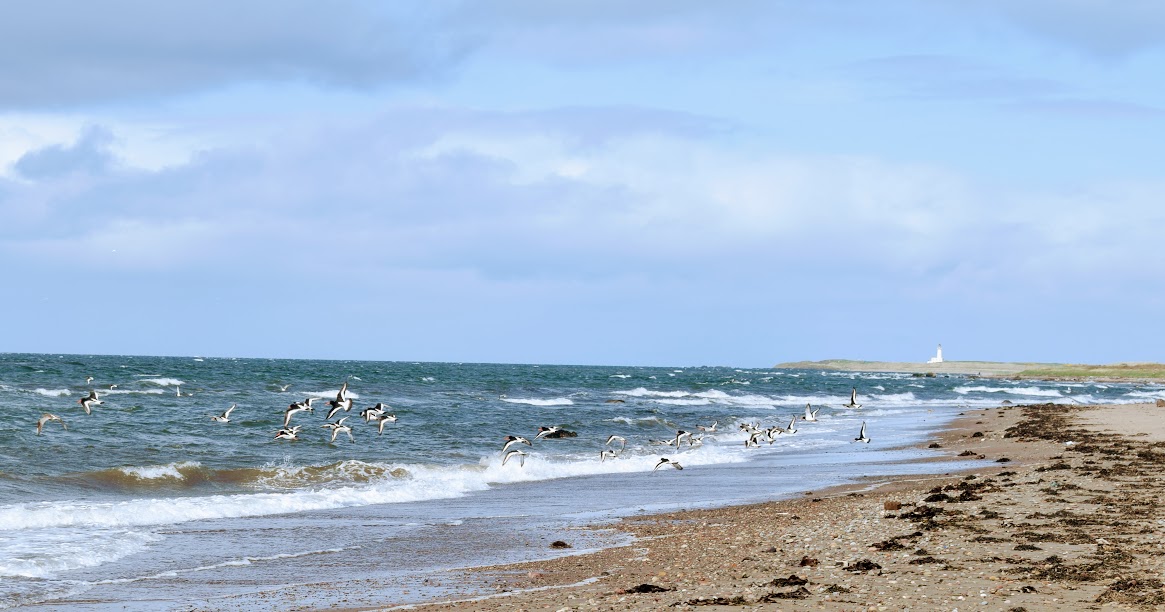![]() Car park at southern end of Ainslie Park, Girvan (KA26 0HW) and at Maidens Harbour. Bus service between Girvan and Maidens. Girvan is also served by a train station.
Car park at southern end of Ainslie Park, Girvan (KA26 0HW) and at Maidens Harbour. Bus service between Girvan and Maidens. Girvan is also served by a train station.
![]() Purchase the official Ayrshire Coastal Path Guide Book
Purchase the official Ayrshire Coastal Path Guide Book
View full route description
From Ainslie Park in Girvan head onto the promenade and turn right to walk North. After 1.8km you will see Girvan Boating Pond and a kids play area on your right. Just beyond there the promenade ends and you should turn right (East) to walk through the harbour car park. Continue along the edge of the harbour and past the RNLI Girvan Lifeboat Station, reaching a set of steps. Go up the steps and onto Knockcushan Street. Turn left (East) and at the crossroads turn left again (North) onto Bridge Street. After 130m at the church turn left (North West) onto a minor road. Turn left (South West) after only 100m to cross the River Girvan via Newton Kennedy Bridge. At the crossroads continue straight ahead (West) onto Newton Place, heading towards the shipyard and Coastguard Station. You will reach some landscaped ground on your right. Follow the footpath around the perimeter of it, the water on your left-hand side, to reach the car park for Girvan Golf Course after 350m. Turn right (East) here to walk through the car park and onto Golf Course Road. Turn left (North) then almost immediately right (East) along a residential street to reach a minor road (also called Golf Course Road on the map). Turn left (North) and continue along this road, which skirts the perimeter of the golf course, for 1km until you reach a crossroads. Turn left (North West) then left again (North) after 200m to walk through Girvan Mains Farm. The next section is along a good farm track running parallel to the coast. About 1km along, shortly after passing the Girvan Waste Water Treatment Plant, the road begins to turn inland and a wooden marker post directs walkers left (North) onto the beach along a grass verge. After passing in front of the cottages at Curragh, you can either continue along the beach if the tide allows, or walk along the edge of the field, entering and exiting the field via kissing gates at each end. Return onto the beach once out of the field. 1km beyond Curragh Cottages you will reach Dipple Burn. If the tide and depth of the burn allow, cross it and continue North on the beach. If the burn is not passable, turn right (East) along a track to reach the A77 Trunk Road. Turn left (North) to follow a wide grassy verge behind the DuPont building to a stile. Cross the stile to enter a field and walk around the field edges, eventually returning to the beach. This short tidal de-tour is fully way-marked. Continue North along the sandy beach for approx 1.7km at which point look out for an obvious set of wooden steps built into the sand dunes on your right-hand side. This short inland de-tour takes you around the upcoming Milton Burn and back onto the beach just beyond. If there is a very low tide you may be able to continue along the beach instead of taking the steps. Continue North on the sandy beach for 1.3km, Turnberry Lighthouse visible ahead. On reaching a rocky outcrop at the north end of the bay, turn inland and follow the Ayrshire Coastal Path way-markers North then East across Turnberry Golf Course and out onto the A719. Turn left (North) at A719 to walk along the roadside pavement for 1.2km to reach Maidens. Just past Maidens Primary School, turn left (West) onto Harbour Road where the walk ends at the car park at Maidens Harbour, 100m along.
WALK REVIEW: 10TH APRIL 2017
I did this walk as part of my Ayrshire Coastal Path charity fundraiser for the Mark McCloskey Foundation. This was day 2 and I was walking from Girvan to Ayr, some 25 miles. This section of coastline wasn’t one I was very familiar with so I really enjoyed discovering it: The Lifeboats in Girvan Harbour, the fields of Ayrshire tatties, the white sand of Turnberry Bay, the rugged coastline around Turnberry Lighthhouse, and walking through Trump Turnberry Golf Course. Isle of Arran also made an appearance and it was really strange seeing it from the south! Although not a cold day, it was blustery and I needed my winter hat for most of the way! The joys of coastal walking 😉
I found navigation to be pretty easy on this walk thanks the the ACP way-markers. There was one point in Girvan around about Newton Kennedy Bridge which was a little confusing as the signs seemed to be pointing in opposing directions. I was using the route description from Walkhighlands as a backup and a few times I found that the information didn’t quite match what I was seeing. The bridge in Girvan was one of those times and so I was grateful to have mapped out the route in advance to be able to just follow the directional arrow on my mobile phone using the app 🙂












